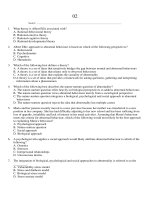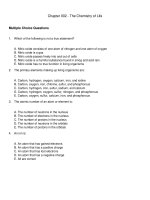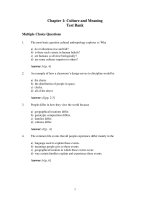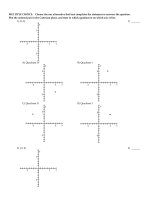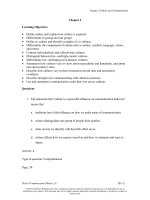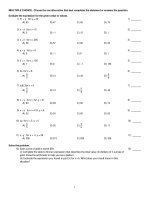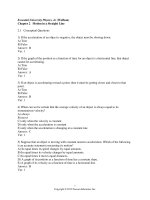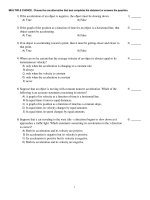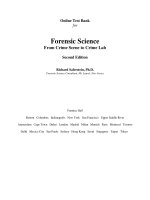Essential university physics 2nd edition richard wolfson test bank
Bạn đang xem bản rút gọn của tài liệu. Xem và tải ngay bản đầy đủ của tài liệu tại đây (578.58 KB, 23 trang )
Essential University Physics, 2e (Wolfson)
Chapter 2 Motion in a Straight Line
2.1 Conceptual Questions
1) If the acceleration of an object is negative, the object must be slowing down.
A) True
B) False
Answer: B
Var: 1
2) If the graph of the position as a function of time for an object is a horizontal line, that object
cannot be accelerating.
A) True
B) False
Answer: A
Var: 1
3) If an object is accelerating toward a point, then it must be getting closer and closer to that
point.
A) True
B) False
Answer: B
Var: 1
4) When can we be certain that the average velocity of an object is always equal to its
instantaneous velocity?
A) always
B) never
C) only when the velocity is constant
D) only when the acceleration is constant
E) only when the acceleration is changing at a constant rate
Answer: C
Var: 1
5) Suppose that an object is moving with constant nonzero acceleration. Which of the following
is an accurate statement concerning its motion?
A) In equal times its speed changes by equal amounts.
B) In equal times its velocity changes by equal amounts.
C) In equal times it moves equal distances.
D) A graph of its position as a function of time has a constant slope.
E) A graph of its velocity as a function of time is a horizontal line.
Answer: B
Var: 1
1
Copyright © 2012 Pearson Education, Inc.
6) Suppose that a car traveling to the west (the -x direction) begins to slow down as it approaches
a traffic light. Which statement concerning its acceleration in the x direction is correct?
A) Both its acceleration and its velocity are positive.
B) Both its acceleration and its velocity are negative.
C) Its acceleration is positive but its velocity is negative.
D) Its acceleration is negative but its velocity is positive.
Answer: C
Var: 1
7) The motion of a particle is described in the velocity versus time graph shown in the figure. We
can say that its speed
A) increases.
B) decreases.
C) increases and then decreases.
D) decreases and then increases.
Answer: D
Var: 1
2
Copyright © 2012 Pearson Education, Inc.
8) The motions of a car and a truck along a straight road are represented by the velocity-time
graphs in the figure. The two vehicles are initially alongside each other at time t = 0. At time T,
what is true about these two vehicles since time t = 0?
A) The truck will have traveled further than the car.
B) The car will have traveled further than the truck.
C) The truck and the car will have traveled the same distance.
D) The car will be traveling faster than the truck.
Answer: A
Var: 1
9) The graph in the figure shows the position of an object as a function of time. The letters H-L
represent particular moments of time. At which moments shown (H, I, etc.) is the speed of the
object
(a) the greatest?
(b) the smallest?
Answer: (a) J (b) I
Var: 1
3
Copyright © 2012 Pearson Education, Inc.
10) The figure shows the position of an object (moving along a straight line) as a function of
time. Assume two significant figures in each number. Which of the following statements about
this object is true over the interval shown?
A) The object is accelerating to the left.
B) The object is accelerating to the right.
C) The acceleration of the object is in the same direction as its velocity.
D) The average speed of the object is 1.0 m/s.
Answer: A
Var: 1
4
Copyright © 2012 Pearson Education, Inc.
11) The figure shows the graph of the position x as a function of time for an object moving in the
straight line (the x-axis). Which of the following graphs best describes the velocity along the xaxis as a function of time for this object?
A)
B)
C)
D)
E)
Answer: D
Var: 1
5
Copyright © 2012 Pearson Education, Inc.
12) An object is moving with constant non-zero acceleration along the +x-axis. A graph of the
velocity in the x direction as a function of time for this object is
A) a horizontal straight line.
B) a vertical straight line.
C) a straight line making an angle with the time axis.
D) a parabolic curve.
Answer: D
Var: 1
13) An object is moving in a straight line along the x-axis. A plot of its velocity in the x direction
as a function of time is shown in the figure. Which graph represents its acceleration in the x
direction as a function of time?
A)
6
Copyright © 2012 Pearson Education, Inc.
B)
C)
D)
7
Copyright © 2012 Pearson Education, Inc.
E)
Answer: C
Var: 1
14) An object starts its motion with a constant velocity of 2.0 m/s toward the east. After 3.0 s, the
object stops for 1.0 s. The object then moves toward the west a distance of 2.0 m in 3.0 s. The
object continues traveling in the same direction, but increases its speed by 1.0 m/s for the next
2.0 s. Which graph below could represent the motion of this object?
A)
B)
8
Copyright © 2012 Pearson Education, Inc.
C)
D)
Answer: D
Var: 1
15) The figure shows the velocity of a particle as it travels along the x-axis. What is the direction
of the acceleration at t = 0.5 s?
A) in the +x direction
B) in the -x direction
C) The acceleration is zero.
Answer: B
Var: 1
9
Copyright © 2012 Pearson Education, Inc.
16) The figure represents the velocity of a particle as it travels along the x-axis. At what value (or
values) of t is the instantaneous acceleration equal to zero?
A) t = 0
B) t = 0.5 s and t = 2 s
C) t = 1 s
Answer: C
Var: 1
17) A ball is thrown directly upward and experiences no air resistance. Which one of the
following statements about its motion is correct?
A) The acceleration of the ball is upward while it is traveling up and downward while it is
traveling down.
B) The acceleration of the ball is downward while it is traveling up and upward while it is
traveling down.
C) The acceleration is downward during the entire time the ball is in the air.
D) The acceleration of the ball is downward while it is traveling up and downward while it is
traveling down but is zero at the highest point when the ball stops.
Answer: C
Var: 1
18) Two objects are thrown from the top of a tall building and experience no appreciable air
resistance. One is thrown up, and the other is thrown down, both with the same initial speed.
What are their speeds when they hit the street?
A) The one thrown up is traveling faster.
B) The one thrown down is traveling faster.
C) They are traveling at the same speed.
Answer: C
Var: 1
10
Copyright © 2012 Pearson Education, Inc.
19) Two objects are dropped from a bridge, an interval of 1.0 s apart, and experience no
appreciable air resistance. As time progresses, the DIFFERENCE in their speeds
A) increases.
B) remains constant.
C) decreases.
D) increases at first, but then stays constant.
E) decreases at first, but then stays constant.
Answer: B
Var: 1
20) Which one of the following graphs could possibly represent the vertical position as a
function of time for an object in free fall?
A)
B)
11
Copyright © 2012 Pearson Education, Inc.
C)
D)
E)
Answer: D
Var: 1
12
Copyright © 2012 Pearson Education, Inc.
2.2 Problems
1) A cat runs along a straight line (the x-axis) from point A to point B to point C, as shown in the
figure. The distance between points A and C is 5.00 m, the distance between points B and C is
10.0 m, and the positive direction of the x-axis points to the right. The time to run from A to B is
20.0 s, and the time from B to C is 8.00 s. As the cat runs along the x-axis between points A and
C
(a) what is the magnitude of its average velocity?
(b) what is its average speed?
Answer: (a) 0.179 m/s
Var: 1
(b) 0.893 m/s
2) The figure shows the position of an object as a function of time. During the time interval from
time t = 0.0 s and time t = 9.0 s
(a) what is the length of the path the object followed?
(b) what is the displacement of the object?
Answer: (a) 5.0 m
Var: 1
(b) 1.0 m
13
Copyright © 2012 Pearson Education, Inc.
3) As part of an exercise program, a woman walks south at a speed of 2.00 m/s for 60.0 minutes.
She then turns around and walks north a distance 3000 m in 25.0 minutes
(a) What is the woman's average velocity during her entire motion?
A) 0.824 m/s south
B) 1.93 m/s south
C) 2.00 m/s south
D) 1.79 m/s south
E) 800 m/s south
(b) What is the woman's average speed during her entire motion?
A) 0.824 m/s
B) 1.93 m/s
C) 2.00 m/s
D) 1.79 m/s
E) 800 m/s
Answer: (a) A (b) C
Var: 1
4) The figure shows the position of an object as a function of time, with all numbers accurate to
two significant figures. Between time t = 0.0 s and time t = 9.0 s
(a) what is the average speed of the object?
(b) what is the average velocity of the object?
Answer: (a) 0.56 m/s
Var: 1
(b) 0.11 m/s
5) If the fastest you can safely drive is 65 mi/h what is the longest time you can stop for dinner if
you must travel 541 mi in 9.6 h total?
A) 1.0 h
B) 1.3 h
C) 1.4 h
D) You can't stop at all.
Answer: B
Var: 50+
14
Copyright © 2012 Pearson Education, Inc.
6) Arthur and Betty start walking toward each other when they are 100 m apart. Arthur has a
speed of 3.0 m/s and Betty has a speed of 2.0 m/s. Their dog, Spot, starts by Arthur's side at the
same time and runs back and forth between them at 5.0 m/s. By the time Arthur and Betty meet,
what distance has Spot run?
Answer: 100 m
Var: 1
7) A racing car accelerates uniformly from rest along a straight track. This track has markers
spaced at equal distances along it from the start, as shown in the figure. The car reaches a speed
of 140 km/h as it passes marker 2. Where on the track was the car when it was traveling at 70
km/h?
A) Before marker 1
B) At marker 1
C) Between marker 1 and marker 2
Answer: A
Var: 1
8) The figure represents the position of a particle as it travels along the x-axis. Between t = 2 s
and t = 4 s, what is (a) the average speed of the particle and (b) the average velocity of the
particle?
Answer: (a) 1.0 m/s
Var: 1
(b) 0.00 m/s
15
Copyright © 2012 Pearson Education, Inc.
9) The position of an object as a function of time is given by x = bt2 - ct, where b = 2.0 m/s2 and
c = 6.7 m/s and x and t are in SI units. What is the instantaneous velocity of the object when
t = 2.2?
A) 1.7 m/s
B) 2.1 m/s
C) 2.3 m/s
D) 2.7 m/s
Answer: B
Var: 22
10) The position of an object is given by x = at3 – bt2+ct, where a = 4.1 m/s3,
b = 2.2 m/s2, c = 1.7 m/s, and x and t are in SI units. What is the instantaneous acceleration of
the object when t = 0.7s?
A) -13 m/s2
B) 2.9 m/s2
C) 4.6 m/s2
D) 13 m/s2
Answer: D
Var: 36
11) The velocity of an object as a function of time is given by
v(t) = 2.00 m/s + (3.00 m/s) t - (1.0 m/s2) t2. Determine the instantaneous acceleration of the
object at time t = 5.00 s.
A) -8.00 m/s2
B) -7.00 m/s2
C) 2.00 m/s2
D) 0.00 m/s2
E) -2.00 m/s2
Answer: B
Var: 5
12) The position of an object as a function of time is given by x(t)= at3 - bt2 + ct - d where
a = 3.6 m/s3, b = 4.0 m/s2, c = 60 m/s, and d = 7.0 m.
(a) Find the instantaneous acceleration at t =2.4 s.
(b) Find the average acceleration over the first 2.4 seconds.
Answer:
(a) 44 m/s2
(b) 18 m/s2
Var: 1
16
Copyright © 2012 Pearson Education, Inc.
13) The velocity of an object is given by the expression v(t) = 3.00 m/s + (4.00 m/s3)t2, where t
is in seconds. Determine the position of the object as a function of time if it is located at x = 1.00
m at time t = 0.000 s.
A) (4.00 m/s)t + 1.00 m
B) (3.00 m/s)t + (1.33 m/s3)t3
C) (4.00 m/s)t
D) 1.33 m
E) 1.00 m + (3.00 m/s)t + (1.33 m/s3)t3
Answer: E
Var: 5
14) The acceleration of an object as a function of time is given by a(t) = (3.00 m/s3)t, where t is
in seconds. If the object is at rest at time t = 0.00 s, what is the velocity of the object at time t =
6.00 s?
A) 18.0 m/s
B) 54.0 m/s
C) 0.00 m/s
D) 15.0 m/s
E) 108 m/s
Answer: B
Var: 5
15) The acceleration of an object as a function of time is given by a(t) = (3.00 m/s3)t, where t is
in seconds. If the object has a velocity 1.00 m/s at time t = 1.00 s, what is the displacement of
the object between time t = 2.00 s and time t = 4.00 s?
A) 33.0 m
B) 30.0 m
C) 36.0 m
D) 27.0 m
Answer: D
Var: 1
16) A car accelerates from 10.0 m/s to 30.0 m/s at a rate of 3.00 m/s2. How far does the car
travel while accelerating?
A) 80.0 m
B) 133 m
C) 226 m
D) 399 m
Answer: B
Var: 50+
17
Copyright © 2012 Pearson Education, Inc.
17) A dragster starts from rest and travels 1/4 mi in 6.70 s with constant acceleration. What is its
velocity when it crosses the finish line?
A) 296 mi/h
B) 269 mi/h
C) 188 mi/h
D) 135 mi/h
Answer: B
Var: 40
18) An airplane that is flying level needs to accelerate from a speed of 2.00 × 102 m/s to a speed
of 2.40 × 102 m/s while it flies a distance of 1.20 km. What must be the acceleration of the
plane?
A) 4.44 m/s2
B) 2.45 m/s2
C) 7.33 m/s2
D) 5.78 m/s2
E) 1.34 m/s2
Answer: C
Var: 1
19) A runner maintains constant acceleration after starting from rest as she runs a distance of
60.0 m. The runner's speed at the end of the 60.0 m is 9.00 m/s. How much time did it take the
runner to complete the 60.0 m distance?
A) 6.67 s
B) 15.0 s
C) 9.80 s
D) 10.2 s
E) 13.3 s
Answer: A
Var: 1
20) An object starts from rest at time t = 0.00 s and moves in the +x direction with constant
acceleration. The object travels 12.0 m from time t = 1.00 s to time t = 2.00 s. What is the
acceleration of the object?
A) -12.0 m/s2
B) 24.0 m/s2
C) -4.00 m/s2
D) 4.00 m/s2
E) 8.00 m/s2
Answer: E
Var: 5
18
Copyright © 2012 Pearson Education, Inc.
21) A car starts from rest and accelerates with a constant acceleration of 1.00 m/s2 for 3.00 s.
The car continues for 5.00 s at constant velocity. How far has the car traveled from its starting
point?
A) 24.0 m
B) 9.00 m
C) 19.5 m
D) 4.50 m
E) 15.0 m
Answer: C
Var: 1
22) A ball rolls across a floor with an acceleration of 0.100 m/s2 in a direction opposite to its
velocity. The ball has a velocity of 4.00 m/s after rolling a distance 6.00 m across the floor.
What was the initial speed of the ball?
A) 4.15 m/s
B) 5.85 m/s
C) 4.60 m/s
D) 5.21 m/s
E) 3.85 m/s
Answer: A
Var: 1
23) A car is 200 m from a stop sign and traveling toward the sign at 40.0 m/s. At this time, the
driver suddenly realizes that she must stop the car. If it takes 0.200 s for the driver to apply the
brakes, what must be the magnitude of the constant acceleration of the car after the brakes are
applied so that the car will come to rest at the stop sign?
A) 2.89 m/s2
B) 3.89 m/s2
C) 4.17 m/s2
D) 3.42 m/s2
E) 2.08 m/s2
Answer: C
Var: 1
24) A speeding car is traveling at a constant 30.0 m/s when it passes a stationary police car. If
the police car delays for 1.00 s before starting, what must be the magnitude of the constant
acceleration of the police car to catch the speeding car after the police car travels a distance of
300 m?
A) 6.00 m/s2
B) 3.00 m/s2
C) 7.41 m/s2
D) 1.45 m/s2
E) 3.70 m/s2
Answer: C
Var: 1
19
Copyright © 2012 Pearson Education, Inc.
25) A soccer ball is released from rest at the top of a grassy incline. After 8.6 seconds, the ball
travels 87 meters and 1.0 s after this, the ball reaches the bottom of the incline.
(a) What was the magnitude of the ball's acceleration, assume it to be constant?
(b) How long was the incline?
Answer: a) 2.4 m/s2 b) 110 m
Var: 50+
26) A package is dropped from a helicopter moving upward at 15 m/s If it takes 16.0 s before the
package strikes the ground, how high above the ground was the package when it was released if
air resistance is negligible?
A) 810 m
B) 1000 m
C) 1200 m
D) 1500 m
Answer: B
Var: 25
27) A ball is projected upward at time t = 0.0 s, from a point on a roof 90 m above the ground.
The ball rises, then falls and strikes the ground. The initial velocity of the ball is 36.2 m/s if air
resistance is negligible. The time when the ball strikes the ground is closest to
A) 9.4 s
B) 9.0 s
C) 8.7 s
D) 9.7 s
E) 10 s
Answer: A
Var: 50+
28) At the same moment from the top of a building 3.0 × 102 m tall, one rock is dropped and one
is thrown downward with an initial velocity of 10 m/s. Both of them experience negligible air
resistance. How much EARLIER does the thrown rock strike the ground?
A) 0.95 s
B) 0.86 s
C) 0.67 s
D) They land at exactly the same time.
Answer: A
Var: 21
20
Copyright © 2012 Pearson Education, Inc.
29) Two identical objects A and B fall from rest from different heights to the ground and feel no
appreciable air resistance. If object B takes TWICE as long as object A to reach the ground, what
is the ratio of the heights from which A and B fell?
A) hA/hB = 1/ 2
B) hA/hB = 1/2
C) hA/hB = 1/4
D) hA/hB = 1/8
Answer: C
Var: 1
30) A foul ball is hit straight up into the air with a speed of 30.0 m/s.
(a) Calculate the time required for the ball to rise to its maximum height.
(b) Calculate the maximum height reached by the ball.
(c) Determine the time at which the ball pass a point 25.0 m above the point of contact between
the bat and ball.
(d) Explain why there are two answers to part (c).
Answer:
(a) 3.06 s
(b) 45.9 m
(c) 0.995 s and 5.13
(d) One value is for the ball traveling upward; one value is for the ball traveling downward.
Var: 1
31) A rock is dropped from the top of a vertical cliff and takes 3.00 s to reach the ground below
the cliff. A second rock is thrown vertically from the cliff, and it takes this rock 2.00 s to reach
the ground below the cliff from the time it is released. With what velocity was the second rock
thrown, assuming no air resistance?
A) 4.76 m/s upward
B) 5.51 m/s downward
C) 12.3 m/s upward
D) 4.76 m/s downward
E) 12.3 m/s downward
Answer: E
Var: 1
32) To determine the height of a flagpole, Abby throws a ball straight up and times it. She sees
that the ball goes by the top of the pole after 0.50 s and then reaches the top of the pole again
after a total elapsed time of 4.1 s. How high is the pole above the point where the ball was
launched? (You can ignore air resistance.)
A) 10 m
B) 13 m
C) 16 m
D) 18 m
E) 26 m
Answer: A
Var: 1
21
Copyright © 2012 Pearson Education, Inc.
33) A test rocket is fired straight up from rest with a net acceleration of 20.0 m/s2. After 4.00
seconds the motor turns off, but the rocket continues to coast upward with no appreciable air
resistance. What maximum elevation does the rocket reach?
A) 487 m
B) 327 m
C) 320 m
D) 408 m
E) 160 m
Answer: A
Var: 1
34) A toy rocket is launched vertically from ground level (y = 0.00 m), at time t = 0.00 s. The
rocket engine provides constant upward acceleration during the burn phase. At the instant of
engine burnout, the rocket has risen to 72 m and acquired a velocity of
The rocket
continues to rise in unpowered flight, reaches maximum height, and falls back to the ground with
negligible air resistance. The speed of the rocket upon impact on the ground is closest to
A) 48 m/s
B) 44 m/s
C) 39 m/s
D) 54 m/s
E) 59 m/s
Answer: A
Var: 50+
35) A ball is projected upward at time t = 0.00 s, from a point on a roof 70 m above the ground
and experiences negligible air resistance. The ball rises, then falls and strikes the ground. The
initial velocity of the ball is 28.5 m/s. Consider all quantities as positive in the upward direction.
The velocity of the ball when it is 39m above the ground is closest to
A) -38 m/s.
B) -30 m/s.
C) -23 m/s.
D) -15 m/s.
E) -45 m/s.
Answer: A
Var: 50+
22
Copyright © 2012 Pearson Education, Inc.
36) On the earth, when an astronaut throws a 0.250-kg stone vertically upward, it returns to his
hand a time T later. On planet X he finds that, under the same circumstances, the stone returns to
his hand in 2T. In both cases, he throws the stone with the same initial velocity and it feels
negligible air resistance. The acceleration due to gravity on planet X (in terms of g) is
A) g/4.
B) g/2.
C) g/ 2 .
D) g 2 .
E) 2g.
Answer: B
Var: 1
37) Two identical stones are dropped from rest and feel no air resistance as they fall. Stone A is
dropped from height h, and stone B is dropped from height 2h. If stone A takes time t to reach the
ground, stone B will take time
A) 4t.
B) 2t.
C) t 2 .
D) t/ 2 .
E) t/2.
Answer: C
Var: 1
38) A rock is thrown directly upward from the edge of the roof of a building that is 66.2 meters
tall. The rock misses the building on its way down, and is observed to strike the ground 4.00
seconds after being thrown. Neglect any effects of air resistance. With what speed was the rock
thrown?
Answer: 3.05 m/s
Var: 50+
39) A rocket takes off vertically from the launchpad with no initial velocity but a constant
upward acceleration of 2.25 m/s2. At 15.4 s after blastoff, the engines fail completely so the only
force on the rocket from then on is the pull of gravity.
(a) What is the maximum height the rocket will reach above the launchpad?
(b) How fast is the rocket moving at the instant before it crashes onto the launchpad?
(c) How long after engine failure does it take for the rocket to crash onto the launchpad?
Answer: (a) 328 m (b) 80.2 m/s (c) 11.7 s
Var: 1
23
Copyright © 2012 Pearson Education, Inc.
